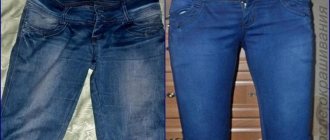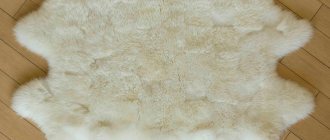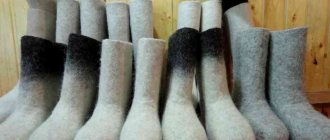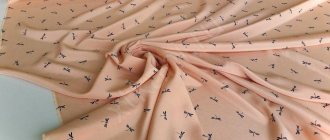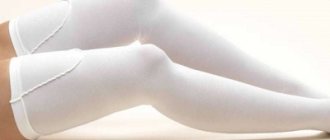Sheepskin is a natural material consisting of sheep skin with fur. It is used to sew sheepskin coats, make rugs and chair covers, covers for car seats, blankets and blankets. It retains heat perfectly and maintains a feeling of comfort. However, sheepskin, like any other material, can become dirty and lose its attractive appearance. Moreover, mold fungi and mites can develop in thick fur, which, together with dust clogged between the fibers, create an ideal environment for the proliferation of pathogenic microbes and the development of allergic reactions. Not only does sheepskin become dull and turn into a matted gray lump, but it can also emit an unpleasant, musty odor. And then there is only one way out - you need to wash it.
Basic rules for washing sheepskin
When looking for solutions on how to wash sheepskin, you need to assess the degree of soiling. Sometimes all you need to do is shake it or vacuum it to get rid of dust, crumbs, pet hairs and other debris. Fur cleaned of dust contamination can even become lighter and cleaner from such a simple procedure. If the stains are strong, then you should use a solution of ammonia and water, which will effectively remove all stains and clean contaminated areas. The sheepskin is treated with a sponge soaked in this solution until the stains disappear. Such a “dry” wash does not always give the desired result.
Is it possible to wash sheepskin in water and how to do it correctly. There are simple rules that will help you wash with the least risk to your item:
- Before washing sheepskin, it must be shaken out to remove crumbs, dust and various small debris.
- Natural materials are washed in warm water. It is strictly forbidden to use hot (over 40 degrees) water, it can mat the wool.
- Gel-based detergents are suitable for washing. If such products are not available, you can use regular liquid soap (toilet soap) or kitchen dishwashing liquid.
- You should absolutely not use chlorine bleach.
- When washing, you should not rub the sheepskin too much or try to intensively wash away dirt. It is best to soak the contaminated item in water for 20 minutes, after which the stains will come off even after a light rinse.
- It is best to dry sheepskin with natural ventilation. Avoid proximity to heaters, fireplaces, and direct sunlight.
Important! Those who love perfect cleanliness and frequent washing should understand that it is not recommended to wash sheepskin frequently. This may cause the item to become unusable. Washing should be done no more than once a month or dry cleaning methods can be used.
Types of envelopes
Blanket envelopes for babies are a relatively recent invention that has made it easier to get your baby ready for a walk. Previously, they wrapped the child in a regular blanket, fixing the free edge. During a walk in cold weather, the baby had practically no opportunity to move.
The envelopes are made spacious enough, and the baby, lying in the stroller, can move his arms and legs. The function of the product is to protect the baby from wind and cold, to simplify getting ready for a walk, which is facilitated by the cut and the presence of fasteners.
When choosing an envelope for discharge, the time of year when the child is born is taken into account. Products are warm and light - winter, demi-season, summer. Accordingly, the main differences relate to the amount and characteristics of the filler. The same factor influences how best to wash the item.
To make the inner, insulating layer, use:
- synthetic filler (sintepon, holofiber, etc.);
- wool;
- cotton wool;
- membrane material.
In addition, there are blanket envelopes without filling - they are knitted from wool or acrylic threads. In order not to spoil the item, you need to know how to wash it correctly. The choice of washing method depends on the materials from which the envelope is made.
Washing sheepskin in a washing machine
When deciding how to wash and clean sheepskin and whether it is possible to use an automatic washing machine, you should determine whether it will fit into the washing drum. If this is not possible, there is no need to try to fold or crumple the item so that it fits. It is better to wash the sheepskin by hand or take it to the dry cleaner.
Rules for washing in an automatic machine:
- Before washing, you should shake out the sheepskin to remove small debris and dust particles.
- The next step is to treat heavily soiled stains. You can use ammonia mixed with water, which will remove all contaminants.
- When washing in a machine, it is best to use gel detergents rather than dry powders.
- For washing, you should choose a mode designed for delicate items or wool.
- The water temperature should not be hot (up to 40 degrees). It is better to set it to 30 degrees - this is the best temperature for washing natural fur products.
- The spin speed should not exceed 600 rpm. This is enough to get rid of excess water after rinsing.
After learning how to wash sheepskin in the washing machine, you need to think about drying. The product is dried in the unfolded position. Make sure that the fur is facing out. Using your hands, you need to carefully straighten the sheepskin, lightly smooth and fluff the fur. During the drying process, you should periodically shake the skin and stretch it a little so that it does not shrink.
Advice! To prevent a sheepskin item from losing its original shape and shrinking, it should absolutely not be dried on a radiator.
How to dry something properly?
To prevent the fur envelope from losing its qualities and becoming deformed, it is important to follow the basic drying rules. It is better to dry the item in the fresh air. Since the envelope is used mainly in winter, it is impossible to ensure that the product dries completely outside. Therefore, you need to know how to get rid of excess moisture at home.
Do not dry a sheepskin envelope on radiators or near heating appliances.
The sheepskin should dry naturally. Of course, this will take more time, but this option is the most correct. If the top of the envelope is lined with waterproof material, then for drying it is necessary to turn the product with the fur outward.
Mothers dry children's winter envelopes as follows:
- turn the thing inside out;
- Place on a dry, soft towel that absorbs moisture well;
- rolled into a tight roll;
- lightly press the roller;
- change a wet towel to a dry one;
- repeat the procedure until the water stops imprinting on the litter.
Then the winter envelope should be laid out on a horizontal surface for further drying. A cotton sheet or terry towel is also placed under the bottom.
How to wash sheepskin fur covers at home
If the sheepskin product is too large to be placed in the drum of an automatic machine, it is washed by hand. This applies to blankets, car covers, and capes. This is not a difficult task, but it is labor-intensive.
- It is necessary to stock up on a large, spacious container for washing; usually a bathtub is used.
- You should prepare the product: shake it out, remove stuck small objects and debris.
- If necessary, treat dirt stains or worn-out, dirty areas.
- Pour warm (up to 40 degrees) water into a basin, dissolving one or two caps of gel detergent in it. Can be washed with liquid soap or shampoo. If your goal is to get rid of microscopic dust mites that live in fur, then you should use dog shampoo.
- The sheepskin product must be soaked in soapy water for 30 minutes.
- When washing, you must avoid sudden movements, do not rub the skin too hard or tug at the fur.
- You need to rinse the covers in several waters until the detergent is completely removed.
- It is recommended to dry the sheepskin in a horizontal position, periodically shaking and stretching slightly.
Important! The sheepskin should not be twisted to remove excess water. It is best to blot it with an absorbent terry towel.
We recommend:
How to wash a duvet
Important Rules
Sheepskin items can be washed by hand or machine washed on delicate programs. However, for any type of care there are 5 important rules, the observance of which will keep the item in its original form:
- Do not use granulated powders or enzymes, bleaches or alkalis. Substances in a liquid state are excellent, suitable for wool and silk items. It is also allowed to use animal shampoos, liquid soaps and dishwashing gels without dyes.
- The water temperature needs to be almost cold, comfortable heating – 30°C degrees.
- Can't be soaked.
- Sheepskin can only be dried under natural conditions. Heating devices, hair dryers, open fires, and bright sun are prohibited.
- Cannot be ironed.
By following the rules of regular care, you can wash sheepskin at home without much additional effort. In addition, there is a recommendation to wash such products as rarely as possible, no more than once every 30 calendar days.
Comfortable and comfortable clothes for every day.
Floor coverings, rugs, and bedspreads are usually regularly dusted off to remove dust accumulations. During cleaning, they should be thoroughly vacuumed dry.
How to wash a sheepskin rug
Since the rug is a voluminous product, it will not be possible to use a washing machine. Must be washed by hand.
Rules for using a sheepskin rug:
- Daily shaking out of sheepskin flooring should become a rule for every housewife.
- Rugs should be vacuumed once or twice a week, running a brush through the wool. This procedure will help get rid of debris stuck in the deep layers of fur.
- A sheepskin rug must be washed at least once a month. This is done manually, with the addition of liquid detergent. After washing, it should be rinsed in several waters and dried in a horizontal position with the fur facing up.
If your sheepskin rug has turned yellow, you can bleach it. To do this, take two tablespoons of a 3% hydrogen peroxide solution and dilute them in 1 liter of cold water. Gently moisten the fur with a sponge, avoiding getting the base too wet. After processing, the sheepskin should dry naturally. If treatment is insufficient, you can increase the concentration of hydrogen peroxide.
Removing stains and enhancing beauty
Manipulations to remove stains, add shine and whiteness can be carried out both before and after washing, and if the item is slightly dirty, then you don’t have to wash it, but simply eliminate some problems using folk methods:
- You can remove stains with ammonia, diluted twice with water.
- You can add shine and restore brightness with crushed walnut kernels wrapped in gauze.
- Hydrogen peroxide will help get rid of yellowness.
- You can restore softness with a mixture of 0.5 liters of water, a tablespoon of Vaseline and 1 chicken egg yolk. The leather base of the rug is processed.
What to do if the sheepskin becomes stiff after washing
If after washing, rinsing and drying the sheepskin has become hard, then it is urgently necessary to revive it. To do this, you should prepare a softening composition. You need to take one tablespoon each of baby cream and glycerin (sold at the pharmacy) and mix them with a glass of water. This mixture should be treated with the inner part of the sheep skin. The product should be left to soak and soften for 30 minutes, after which it will become soft.
Some housewives use sunflower oil, animal fat, and fat-based creams to soften sheepskin.
If all procedures for washing sheepskin were done correctly, the product has every chance of maintaining an attractive appearance for a long time, even after several washes.
Useful tips
Information that a person who decides to wash a faux fur product should have:
If it is possible to refuse washing, then it should be used. Excessive contact of the product with water will deteriorate its appearance.- To make the pile smooth, use fabric conditioner.
- When the fur is dry, it needs to be combed. The comb is used with a wide distance between the teeth. You can also use a massage brush. There is no need to push the comb too far into the pile so as not to catch the fabric base.
- If you need to wash a hood or collar with fur, it is better to unfasten it from the main product.
- White fluff is handled with care. Stain removers are not used to eliminate yellowness and grayness.
- The matted pile is sprayed with warm water, allowed to dry, and then combed. You can carefully walk the steamer over the product without pressing the device too tightly against the fabric.
Before using any chemicals that have not previously been used on fur, a test is carried out.
The product is applied to an inconspicuous area and the reaction of the fiber is monitored. If no pathological changes occur, treatment can be continued.
